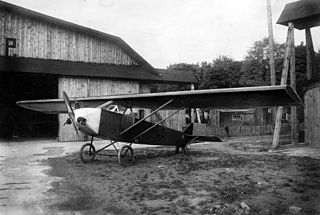Related Research Articles

The Cranwell CLA.3 was a parasol winged single-engined, single-seat British aircraft built to compete in the Lympne air races of 1925. It was designed and built by an amateur group drawn from staff and pupils at the RAF College Cranwell. Though it won one prize and set a Class record, only one CLA.3 was made.
The Nakajima P-1 was a 1930s Japanese single engine, single seat biplane intended for night mail flights, derived from the Nakajima E4N3 Naval reconnaissance seaplane. Nine were built.
The Junkers T 23 was a two-seat, single-engined experimental training aircraft, built in Germany in the early 1920s. It could be configured either as a parasol winged monoplane or as a biplane to compare handling characteristics. 4 were constructed.

The Farman FF 65 Sport was a French built light biplane, with a single engine and tandem seats, intended for sport and touring. First flown in 1919, it achieved modest sales at home and abroad in the early 1920s. Two unusual modifications produced a biplane glider and a low aspect ratio parasol wing machine.

The Hanriot HD.15 was a French two seat fighter aircraft fitted with a supercharger for good high altitude performance, built in the 1920s. Three were ordered by Japan but lost at sea during delivery.

The Blériot XXI was an early French aircraft built by Blériot Aéronautique.

The Nieuport-Delage NiD 580 R.2 was a contender for a French government contract for a long range, two seat reconnaissance aircraft, issued in 1928. There were eight prototypes in the 1931-2 contest and the NiD 580 was not selected for production.

The Medwecki HL 2 was a Polish two seat lightplane flown in 1927. Handicapped by a low power, unreliable engine, its flying life lasted little more than a month.

The Zalewski W.Z.XI Kogutek I was a basic, single seat sport aircraft designed and built in Poland in the 1920s. Its engine was also designed and built by Zalewski, making it the first all-Polish aircraft to fly.
The Grzmilas Orkan II was a Polish one-off, single-seat sports aircraft. It came second in the second National Lightplane Contest held soon after its first flight, with outstanding take-off and climb characteristics. Its designer and builder continued to use it until 1939.
Kawanishi's first aircraft, the Kawanishi K-1, was designed as a mail carrier. It was the first Japanese aircraft to receive a Certificate of Airworthiness from the Aviation Bureau. It won a prize in a national contest but was not a commercial success and only one was built.
The sole Kawanishi K-2 was the first specialized Japanese racing aircraft. The advanced, single-seat low-wing monoplane's first flight was in the late summer of 1921. It had a promisingly high maximum speed but a career limited by numerous minor accidents produced no victories or records.
The Itoh Emi 1 was Japan's second successful civil aircraft and the first design of Orojiro Itoh.
The Itoh Emi 2 was a revised and cleaned up development of his first aircraft, the Itoh Emi 1.
The Itoh Emi 3 was the first Japanese civil passenger carrying seaplane, flown in 1917 and used for commercial demonstrations and passenger flights.
The Itoh Tsurubane No.1 was a single seat aviation demonstrator and trainer biplane first flown in Japan in 1918.
The Itoh Emi 13 was a two seat Japanese trainer, designed for the Itoh flying school and introduced in two versions in 1920 and 1921.
The Itoh Emi 16 Fuji-go (Fuji), built in 1920, was intended as a cheap and simple general purpose civil biplane but gained publicity with exhibition flights and successful speed and altitude contests against higher-powered fighter aircraft.
The Itoh Emi 29 Taihoku-go was a 1920s Japanese civil transport with its two passengers in a enclosed cabin. It was the first of this "limousine" type to be built in Japan; the only example flew the Osaka-Tokyo route for a while.
The Itoh Emi 30 was a small, single-engined, sports biplane built in Japan in 1922. Though it attracted attention by being the smallest Japanese aircraft of its time, the sole example was mostly used as an aerobatics trainer.